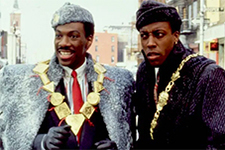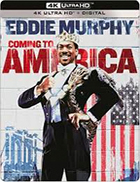Coming to America (4K UHD)
|  Following his breakout role in Walter Hill’s 48 Hrs. (1982), Eddie Murphy played a series of fast-talking, street-smart, wise-ass characters, the kind who can’t be conned because they are always one step ahead. For the first six years of his big-screen career, his on-screen persona was consistent, whether he was playing a character named Reggie Hammond or Chandler Jarrell or Axel Foley. Yet, for his sixth starring role in Coming to America, Murphy did something completely different by playing a wide-eyed innocent, a fish out of water, a man whose first utterance of “f--- you” is done in reply to someone else in the naïve, mistaken belief that it is some kind of greeting. In other words, for the first time in his career, Eddie Murphy was playing a non-Eddie Murphy character. Murphy stars as Prince Akeem, the wealthy and pampered heir to the fictional African country of Zamunda, who travels to the United States after his 21st birthday to find a wife. The film’s premise is that Akeem does not want to submit to Zamunda’s long-standing tradition of arranged marriages. His already-selected bride-to-be is little more than a beautiful sycophant trained to cater to his every whim (his attempts to get her to tell him what she likes garners only responses of “Whatever you like” accompanied by a bow). While that may sound like a dream to certain single-minded male narcissists, Akeem is looking for something more: real love in a real relationship with someone he can view as his equal. Murphy’s character is, in many ways, a figure of genuine integrity and upstanding progressive morality. As he tells his best friend and manservant, Semmi (Arsenio Hall), he wants a woman who will arouse his intellect, as well as his loins, which is about as close to feminism as one is going to get in a 1980s Eddie Murphy vehicle. So, at the behest of father, King Jeffe Joffer (James Earl Jones, who else?), who thinks he just wants to “sow his royal oats,” Akeem heads off to America with Semmi in tow. Knowing nothing about anything outside of Zamunda, he demands to be taken to Queens (because where better to find one?), marvels at the freedom of people throwing trash in the street, dresses himself and Semmi in American-style clothing, and seeks out the most meager accommodations he can find (which turns out to be a rat-infested one-room apartment in a squalid housing project run by Frankie R. Faison’s cigar-chomping landlord). Having never even had to brush his own teeth or tie his own shoes (“an overrated experience,” King Joffer tells him), Akeem revels in his newfound freedom, which he uses to recreate himself as goat herder-turned-exchange student. In his innocent mind, he doesn’t want a woman who might be attracted to his money and royal heritage. He and Semmi get minimum-wage jobs working at a McDonald’s knock-off called McDowell’s that is owned and run by Cleo McDowell (John Amos), a self-made made man whose oldest daughter, Lisa (Shari Headley), works as his business manager and immediately catches Akeem’s eye. Unfortunately, she is dating Darryl Jenks (Eriq La Salle), a preening lothario who is heir to Soul Glo, a Jheri curl-esque brand of oily hair products (the film has more than its share of jabs at ’80s African American culture). Cleo, well-intentioned and decent though he may be, is determined that Lisa will marry someone of means because he knows what it is like to struggle your way out of poverty. Like any good dad, he just wants his daughter to have it better than he did, which blinds him to the glaring fact that Darryl is a facetious scumbag. Akeem sets about wooing Lisa anyway, which he does with simple decency and respect, something that she clearly has not seen from many boyfriends and which she finds immediately attractive. Romance was a subject almost entirely absent from Murphy’s previous films, but here he proves to be a genuine romantic, delivering a performance that allows for plenty of laughs from Akeem’s naivete, but never at his expense. The screenplay by David Sheffield and Barry W. Blaustein (from a story concocted by Murphy) doesn’t do anything particularly original, and the arc is perfectly clear early on, offering few narrative surprises as it dutifully moves through the paces. However, director John Landis, who previously directed Murphy in Trading Places (1983), keeps the story moving along while also allowing plenty of time for various comical digressions, many of which involve Murphy and Hall playing multiple characters, a humorous gambit that makes outstanding use of the gift for mimicry that would come to be a hallmark of subsequent Murphy films, including Vampire in Brooklyn (1995), The Nutty Professor (1996), and its sequel, Bowfinger (1999), and Norbit (2007). It also puts on display Rick Baker’s ingenious make-up effects, which convincingly turns Murphy into an elderly Jewish man who hangs out at a barber shop run by Clarence (also played by Murphy), a loud-mouth know-it-all who claims to have met everyone from Joe Louis to MLK (Arsenio Hall plays another of the barbers). Murphy also turns up as Randy Watson, a hilariously untalented local singer who delivers a horrendously overdone version of Whitney Houston’s “Greatest Love of All” at a neighborhood black pride event that is hosted by Hall’s lecherous Reverend Brown. Coming to America was Murphy’s sixth starring vehicle in seven years, and it came on the heels of the fantasy-comedy The Golden Child (1986), which was something of a letdown given his previous successes, and the concert film Eddie Murphy Raw (1986), which features some outrageously offensive bits that even he cringes at now. Coming to America built on the softer side of Murphy that could be glimpsed in The Golden Child, where he played a social worker who specializes in missing children and who, therefore, unlike Axel Foley and his other previous characters, is interested in something other than his own success. Murphy shows genuine range in Coming to America and a willingness to sacrifice some raunch for some sweetness, which he would also mine in his touching performance as an insecure, overweight scientist in The Nutty Professor. It was the right corner to turn at the right time, and even though Murphy’s career would drop off sharply over the next few years with a string of misfires and flops, Coming to America proved that he had more to offer than wise cracks and a win-at-all costs ethos.
Copyright © 2020 James Kendrick Thoughts? E-mail James Kendrick All images copyright © Paramount Home Entertainment | |||||||||||||||||||||||||||||
Overall Rating: 


 (3.5)
(3.5)


